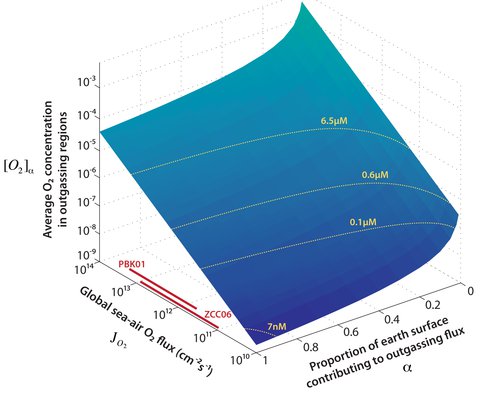2011 Annual Science Report
 Massachusetts Institute of Technology
Reporting | SEP 2010 – AUG 2011
Massachusetts Institute of Technology
Reporting | SEP 2010 – AUG 2011
Atmospheric Oxygen and Complex Life
Project Summary
The biosynthesis of sterols requires oxygen but only in vanishingly low concentrations. Oxygen could be used by algae to make sterols in the surface ocean and, yet, at the same time, it would not be in sufficient concentration to destroy the mass-independent sulfur isotope signal for atmospheric oxygenation.
Large sulfur isotope fractionations have been observed in sulfate reducing bacteria grown in a 'starvation’ regime, much as most natural populations experience. This casts doubt on the hypothesis that the large sulfur isotope fractionations seen in the Neoproterozoic rock record herald an increase in atmospheric oxygen and the inception of a new form of oxidative sulfur cycling.
Project Progress
Oxygen and sterol biosynthesis
The history of oxygen production and accumulation a first-order question for understanding Earth’s evolution and the development of complex life. Among the various geochemical proxies for the presence of O2 in the environment, steroidal molecular fossils offer a unique record of O2 where it was first produced and consumed by biology: in sunlit aquatic habitats. As steroid biosynthesis requires molecular oxygen, fossil steranes have been used to draw inferences about aerobiosis in the early Precambrian. However, better quantitative constraints on the O2 requirement of this biochemistry would clarify the implications of these molecular fossils for environmental conditions at the time of their production. This year we demonstrated that steroid biosynthesis (Figure 1) is a microaerobic process, enabled by dissolved O2 concentrations in the nanomolar range. We developed a model (Figure 2) showing that microaerobic marine environments, where steroid biosynthesis was possible, could have been widespread and persistent for long periods of time prior to the earliest geologic and isotopic evidence for atmospheric O2. In the late Archean, molecular oxygen likely cycled as a biogenic trace gas, much as compounds such as dimethylsulfide do today.
Large S isotope fractionation does not require disproportionation
Min Sub Sim, a MIT graduate student supervised by Tanja Bosak and Shuhei Ono, has demonstrated that a pure culture of sulfate reducing bacteria fractionates sulfur isotope as much as 66 per mil, in contrary to previous works that suggest upper limit of 47 per mil. This finding, published in Science in July, questions the major line of evidence for the late Proterozoic oxygenation since oxidative sulfur cycle is not required to explain increased magnitude sulfur isotope fractionation during that time. We suggest that the increased sulfur isotope fractionation in the rock records may reflect changing nature of organics and not directly linked to the oxygen evolution.
Figure 1. Sterol biosynthesis pathway of yeast showing how an isotopic label in glucose and be used to detect initiation of sterol production versus oxygen supplied to an anaerobic culture of yeast
Figure 2. The modeled average dissolved oxygen concentration in oxygenated regions of the Archean ocean, as a function of the sea-to-air O2 flux and the proportion of the earth’s surface contributing to that flux. The larger the outgassing flux, and the smaller the fraction of the earth’s surface it comes from, the more oxygenated surface waters in that region must be. Yellow contours indicate the dissolved oxygen concentrations of the steroid biosynthesis experiments (7nM, 0.6µM and 6.5µM) and the detection limit of the oxygen microelectrode (0.1µM). Red bars indicate the range of O2 fluxes in the Archean atmospheric evolution models of Pavlov et al.(PBK01) 2001 and Zahnle et al. (ZCC06) 2006. Pavlov, AA, LL Brown, and JF Kasting. (2001) UV shielding of NH3 and O2 by organic hazes in the Archean atmosphere. J Geophys Res 106: 23267-23287.
Zahnle, K, M Claire, and D Catling. (2006) The loss of mass-independent fractionation in sulfur due to a Palaeoproterozoic collapse of atmospheric methane. Geobiology 4: 271– 446 283.
Publications
-
Sim, M. S., Bosak, T., & Ono, S. (2011). Large Sulfur Isotope Fractionation Does Not Require Disproportionation. Science, 333(6038), 74–77. doi:10.1126/science.1205103
-
Sim, M. S., Ono, S., Donovan, K., Templer, S. P., & Bosak, T. (2011). Effect of electron donors on the fractionation of sulfur isotopes by a marine Desulfovibrio sp.. Geochimica et Cosmochimica Acta, 75(15), 4244–4259. doi:10.1016/j.gca.2011.05.021
-
Tosca, N. J., Johnston, D. T., Mushegian, A., Rothman, D. H., Summons, R. E., & Knoll, A. H. (2010). Clay mineralogy, organic carbon burial, and redox evolution in Proterozoic oceans. Geochimica et Cosmochimica Acta, 74(5), 1579–1592. doi:10.1016/j.gca.2009.12.001
-
Waldbauer, J. R., Newman, D. K., & Summons, R. E. (2011). Microaerobic steroid biosynthesis and the molecular fossil record of Archean life. Proceedings of the National Academy of Sciences, 108(33), 13409–13414. doi:10.1073/pnas.1104160108
- Summons, R.E. (2012). The Great Oxidation Event [Book Chapter]. Science Year 2012. Chicago: World Book Inc.
-
PROJECT INVESTIGATORS:
-
PROJECT MEMBERS:
David Johnston
Project Investigator
Andrew Knoll
Project Investigator
Dan Rothman
Project Investigator
Nicholas Tosca
Project Investigator
Dianne Newman
Collaborator
Min-Sub Sim
Doctoral Student
-
RELATED OBJECTIVES:
Objective 4.1
Earth's early biosphere.
Objective 4.2
Production of complex life.
Objective 6.1
Effects of environmental changes on microbial ecosystems




